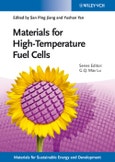The world's ever-growing demand for power has created an urgent need for new efficient and sustainable sources of energy and electricity. Today's consumers of portable electronics also demand devices that not only deliver more power but are also environmentally friendly. Fuel cells are an important alternative energy source, with promise in military, commercial and industrial applications, for example power vehicles and portable devices.
A fuel cell is an electrochemical device that directly converts the chemical energy of a fuel into electrical energy. Fuel cells represent the most efficient energy conversion technologies to-date and are an integral part in the new and renewable energy chain (e.g., solar, wind and hydropower). Fuel cells can be classified as either high-temperature or lowtemperature, depending on their operating temperature, and have different materials requirements. This book is dedicated to the study of high temperature fuel cells. In hightemperature fuel cells, the electrolyte materials are ceramic or molten carbonate, while the electrode materials are ceramic or metal (but not precious metal). High operation temperature fuel cells allow internal reforming, promote rapid kinetics with non-precious materials and offer high flexibilities in fuel choice, and are potential and viable candidate to moderate the fast increase in power requirements and to minimize the impact of the
increased power consumption on the environment.
'Materials for High Temperature Fuel Cells' is part of the series on Materials for Sustainable Energy and Development edited by Prof. Max Q. Lu. The series covers advances in materials science and innovation for renewable energy, clean use of fossil energy, and greenhouse gas mitigation and associated environmental technologies.
A fuel cell is an electrochemical device that directly converts the chemical energy of a fuel into electrical energy. Fuel cells represent the most efficient energy conversion technologies to-date and are an integral part in the new and renewable energy chain (e.g., solar, wind and hydropower). Fuel cells can be classified as either high-temperature or lowtemperature, depending on their operating temperature, and have different materials requirements. This book is dedicated to the study of high temperature fuel cells. In hightemperature fuel cells, the electrolyte materials are ceramic or molten carbonate, while the electrode materials are ceramic or metal (but not precious metal). High operation temperature fuel cells allow internal reforming, promote rapid kinetics with non-precious materials and offer high flexibilities in fuel choice, and are potential and viable candidate to moderate the fast increase in power requirements and to minimize the impact of the
increased power consumption on the environment.
'Materials for High Temperature Fuel Cells' is part of the series on Materials for Sustainable Energy and Development edited by Prof. Max Q. Lu. The series covers advances in materials science and innovation for renewable energy, clean use of fossil energy, and greenhouse gas mitigation and associated environmental technologies.
Table of Contents
PREFACEADVANCED ANODES FOR SOLID OXIDE FUEL CELLS
Introduction
Ni-YSZ Anode Overview
Insights from Real Ni-YSZ Microstructures
Mechanistic Understanding of Fuel Oxidation in Ni-Based Anodes
Poisoning of Ni-Based Anodes
Alternative Anode Materials for Direct Hydrocarbon Utilization
Infiltration as an Alternative Fabrication Method
Summary and Outlook
ADVANCED CATHODES FOR SOLID OXIDE FUEL CELLS
Introduction
Cathodes on Oxygen-Ion-Conducting Electrolytes
Cathodes on Proton-Conducting Electrolytes
Advanced Techniques in Cathode Fabrication
Summary
OXIDE ION-CONDUCTING MATERIALS FOR ELECTROLYTES
Introduction
Oxide Ion Conductivity in Metal Oxide
Electrolyte Efficiency
Strain Effects on Oxide Ion Conductivity
Degradation in Conductivity
Concluding Remarks
PROTON-CONDUCTING MATERIALS AS ELECTROLYTES FOR SOLID OXIDE FUEL CELLS
Introduction
The Principle of Proton-Conducting Oxides
Proton-Conducting Materials for Solid Oxide Fuel Cells
Solid Oxide Fuel Cells Based on Proton-Conducting Electrolytes
Electrode Materials and Anode Reactions for SOFCs Based on Proton-Conducting Electrolytes
Conclusion
METALLIC INTERCONNECT MATERIALS OF SOLID OXIDE FUEL CELLS
Introduction
Oxidation Behaviors of Candidate Alloys
Electrical Properties of Oxide Scale
Surface Modifications and Coatings
New Alloy Development
Summary
SEALANTS FOR PLANAR SOLID OXIDE FUEL CELLS
Introduction
Glass and Glass -
Ceramic Sealants
Mica
Metal Braze
Composite Sealants
Conclusion
DEGRADATION AND DURABILITY OF ELECTRODES OF SOLID OXIDE FUEL CELLS
Introduction
Anodes
Cathodes
Degradation of Solid Oxide Electrolysis Cells
Summary and Conclusions
MATERIALS AND PROCESSING FOR METAL-SUPPORTED SOLID OXIDE FUEL CELLS
Introduction
Cell Architectures
Substrate Materials and Challenges
Cell Fabrication and Challenges
Summary
MOLTEN CARBONATE FUEL CELLS
Introduction
Operating Principle
State-of-the-Art Components
General Needs
Status of MCFC Systems Implementation
INDEX








